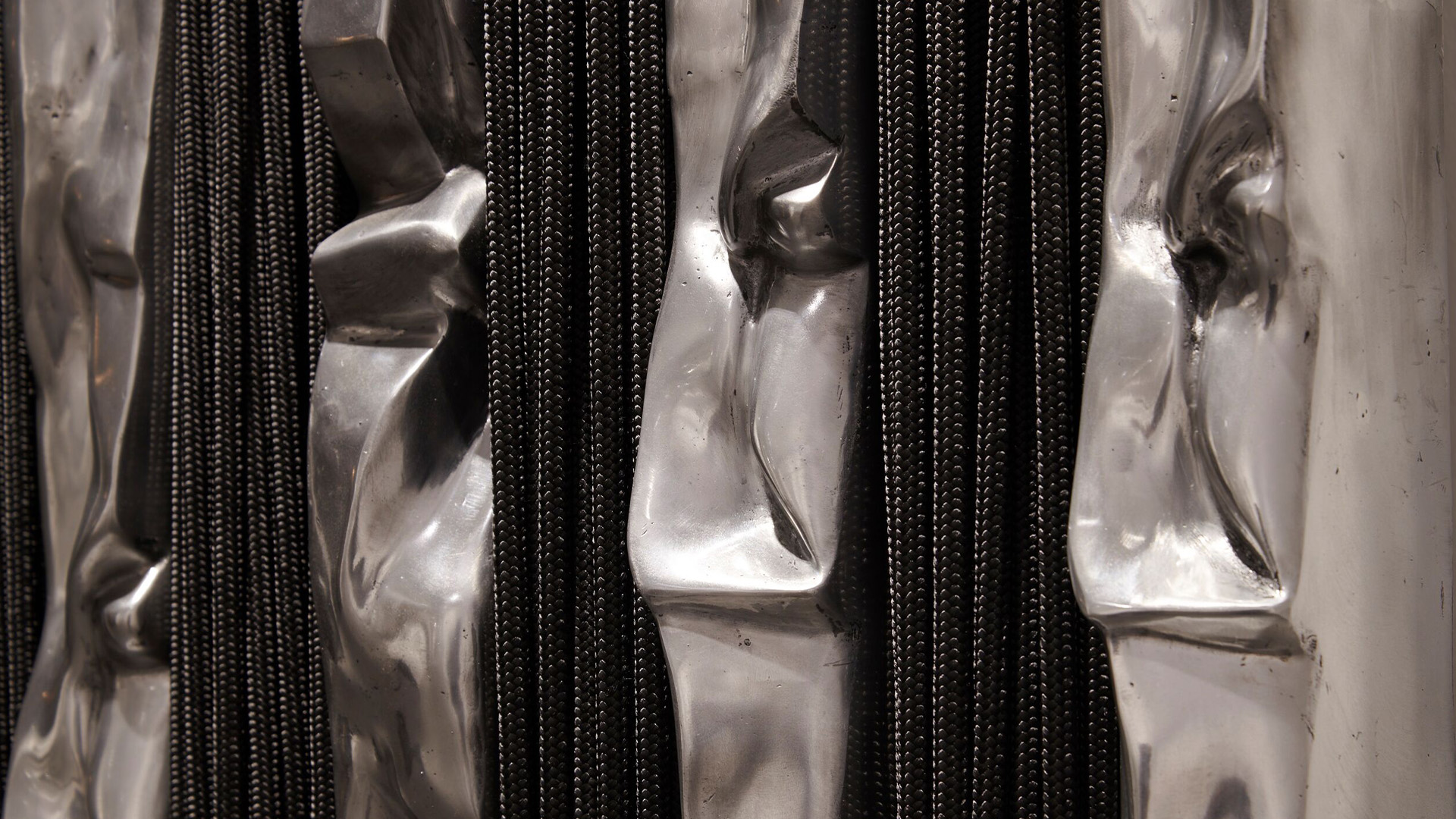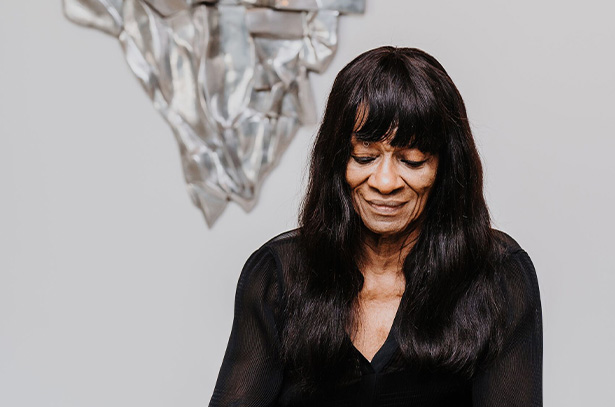
Barbara Chase-Riboud

Over the course of her seven-decade career, Chase-Riboud has created a revolutionary body of work which is defined equally by its inventiveness, technical prowess and fearless engagement with transcultural histories.
Born in Philadelphia PA in 1939, Chase-Riboud currently resides between Paris and Rome. At a young age, she began taking art classes at the Philadelphia Museum of Art and the Samuel S. Fleisher Art Memorial. After graduating high school, Chase-Riboud studied at Temple University’s Tyler School of Art, where she received training in painting, drawing and sculpture.
In 1957, Chase-Riboud was awarded a John Hay Whitney Fellowship at the American Academy in Rome. Introduced to a foundry for the first time, the artist would begin developing a new variation on the ancient lost-wax technique of casting bronze by using sheets of pliable wax that she could bend, fold or bunch in order to cast the ribbons of metal that would later become a signature of her aesthetic. During this period, Chase-Riboud would mold figures from vegetal and animal matter to be cast into large-scale bronzes at a local foundry in Rome, where she still casts her sculptures today. Among important early works is ‘Adam and Eve’ (1958), which depicts intertwining figures under an arching tree—a bravura example of her experimental methods that resonate formally with the textured figures of Alberto Giacometti. It was during her time in Rome that Chase-Riboud would first travel to Egypt and Greece, where encounters with ancient forms and approaches would leave an indelible mark upon her imagination. In 1958, Chase-Riboud’s work was included in the first annual Festival of the Two Worlds in Spoleto, Italy.
Later that year, Chase-Riboud returned to the United States to complete an MFA at Yale University School of Design and Architecture, where she studied with Josef Albers, Philip Johnson, Paul Rand and Alvin Eisenman. The first Black American woman to receive an MFA degree from Yale, Chase-Riboud left for London and, subsequently, Paris, where she settled in 1961.
In Paris, Chase-Riboud established a successful sculpting career, meeting fellow artists and cultural figures such as Alberto Giacometti, James Baldwin, Alexander Calder, Salvador Dalí, Max Ernst, Dorothea Tanning, Man Ray, Lee Miller, and Henri Cartier-Bresson and his protégé, the photojournalist Marc Eugène Riboud, whom she married. On a trip with Riboud in 1965, Chase-Riboud became the first American woman to visit the People’s Republic of China since the country’s political revolution. The following year, she represented the United States in The First World Festival of Black Arts in Dakar, Senegal. These international sojourns and presentations would exert a lasting influence upon the artist’s attitudes toward both sculpture and materials, inspiring her to move beyond conventional Western art historical modes of representation.
From the mid-1960s, Chase-Riboud began to create increasingly abstract sculptures comprising fluid metal forms. A turning point came when she first added fiber to these sculptures, introducing a visual language uniquely her own and escaping what she dubbed ‘the tyranny of the base.’ Chase-Riboud began covering the bases of her sculptures with cascades of silk or knotted wool, rendering the illusion that these textiles supported the metal, defying gravity. Of this breakthrough, Chase-Riboud has said, ‘In the early pieces, I had used bronze in a fluid, liquid way, while the wool was static. So, there was this paradoxical transfer of power from the bronze to the silk or wool.’ This ingenious reversal of hierarchies—a metaphor for upending entrenched power structures—is exemplified by the artist’s powerful steles memorializing Malcolm X. Begun in 1969, four years after the assassination of the famed American Muslim minister and human rights activist, this group of 20 sculptures in the artist’s signature colors of black, red and gold was inspired by funerary steles Chase-Riboud encountered during her travels in China and Cambodia.
Though living in France, Chase-Riboud was deeply engaged with the American civil rights movement of the 1960s, a commitment felt throughout her work in both visual art and literature, and resonant in her oeuvre through the present day.
The 1970s saw numerous landmark moments in Chase-Riboud’s literary career, reflecting this commitment and her unique insight into transcultural histories. In 1974, she published a collection of poems titled ‘From Memphis & Peking,’ edited by Toni Morrison. In 1979, encouraged by Morrison and by her friend Jacqueline Kennedy Onassis, Chase-Riboud released her first novel, based on a poem she had written inspired by Sally Hemings, the enslaved woman who was the mistress of Thomas Jefferson. In 1979, ‘Sally Hemings’ won the Janet Heidinger Kafka Prize for the best novel by an American woman. Chase-Riboud would likewise continue exploring diasporic histories and narratives of enslavement in her sculptures during the 1970s, often creating works that reflected her literary explorations, as in her monumental Zanzibar series named for the island off the coast of Tanzania. The Zanzibar sculptures echo Chase-Riboud’s poem ‘Why Did We Leave Zanzibar?’ (1969-70) and her impressions while touring Africa to accompany an exhibition of her work organized by the US State Department.
Chase-Riboud’s travels and tireless immersions in different cultures continued to shape her vision throughout the 1970s and 1980s. In a seminal sculpture series of this period, Chase-Riboud memorialized Cleopatra with bronze works mining themes of female sexuality and revolutionary power, conveyed by the artist through such imagined objects as the revered Egyptian queen’s bed draped in an armor of intricately woven bronze squares. In the late 1990s, Chase-Riboud began The Monument Drawings, a series of ink and charcoal drawings of imagined monuments honoring literary and historic figures—not only Cleopatra, but also Marquis de Sade, Nelson Mandela, the Queen of Sheba and Anna Akhmatova.
Chase-Riboud has received numerous public commissions over the course of her career. The first of these came in 1967, for which the artist created a fountain titled ‘Meta Mondrian’ for the now-demolished Wheaton Plaza Shopping Center in Rockville MD. Among other major public sculptures is Chase-Riboud’s 1998 work ‘Africa Rising,’ a commission from the US General Services Administration to commemorate an African burial ground discovered in Lower Manhattan.
Since 1990, Chase-Riboud has unfurled a body of work titled La Musica. These sculptures embody music and movement—and their complement, stillness—through daring juxtapositions of materials and sculptural forms. Her newest works from the La Musica series are devoted to the American-born, French singer, dancer and activist Josephine Baker. Baker was the first Black woman to be inducted into the Panthéon—the French national tomb of heroes—in 2021, an event that inspired the first of three monuments Chase-Riboud has made in homage to her. In ‘La Musica Josephine Red/Black’ (2021), an angular arm of elongated bronze evokes the famously elegant limbs of Baker, while a red cord hovers above the ground, inviting the viewer to anticipate the kind of movement, energy and dynamism for which the performer was famous. In a manifesto written for this work and titled ‘A Manifesto for Sculpture in Pursuit of Futurism’ (2021), Chase-Riboud makes a proclamation for the art of the future: ‘Let us jettison the stale geometry of these remnants and clear terrain to host a raucous, swinging romp. Sculpture must not sit still.’
Biography
Selected Solo Exhibitions
Selected Group Exhibitions
Awards & Grants
Public & Special Projects
Bibliography
Monographs
Artist’s Books, Writings & Librettos
Publications
Selected Press
Exhibitions
1 / 2
News
1 / 2
1 / 3
Ursula
1 / 3




















